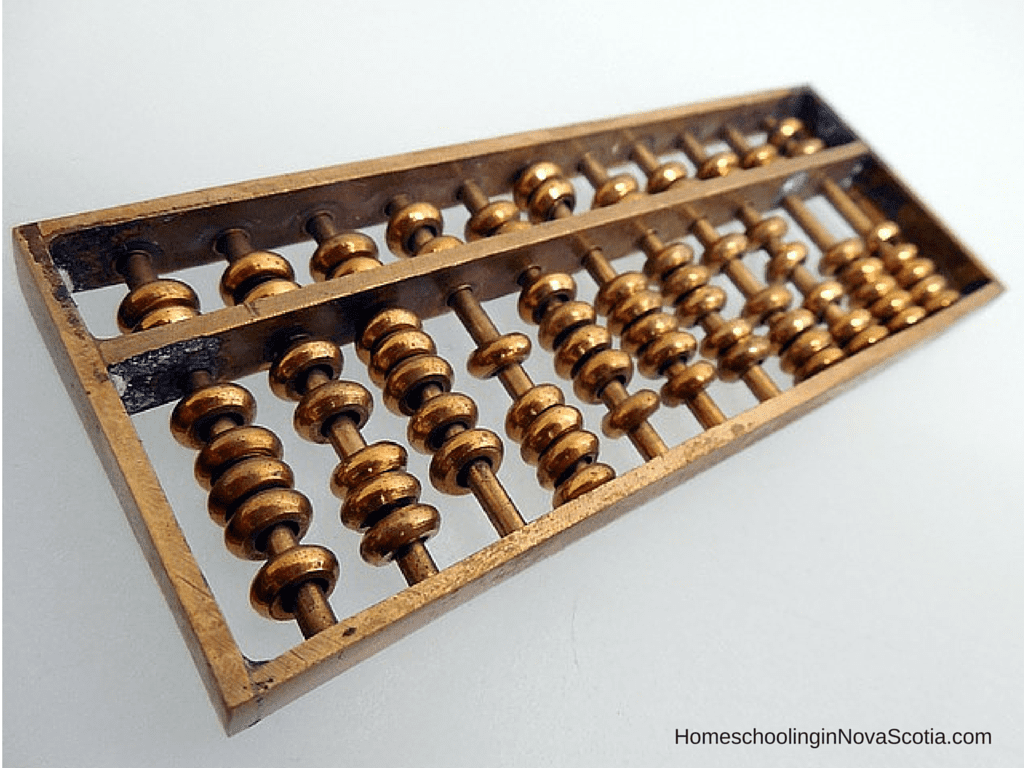What is an abacus? Do you imagine one of these?

That’s more of a baby toy and can’t be used effectively for calculations any more complex than addition and subtraction, but a real abacus can be.
Homeschool Math with the Abacus

The abacus is an ancient calculator that has been used for thousands of years. It is still in use today, especially in Asia and the Middle East. The word “abacus” originally comes from the Greek word “abax” for “counting board”. The Greeks used boards with sand on them to draw out their equations. The Romans used boards with grooves and beads or rocks. The Abacus we are more familiar with originated in Asia.
The Chinese abacus has 7 beads on each rod, with 2 on the top and 5 on the bottom, separated by one horizontal beam.
The Japanese abacus is called a soroban and has 5 beads on each rod, with just one on the top and 4 on the bottom, divided by one horizontal beam (the reckoning bar). It has at least 9 rods, and the number of rods is always an odd number.

Each abacus is set to zero when all of the beads above the bar are up (not in contact with the reckoning bar) and all the beads below the bar are down (not in contact with the reckoning bar). The Japanese abacus pictured above is set to zero. The units rods on the Japanese abacus are the rods with the dots on them. The units rod on the Chinese abacus is the one on the far right.
For either abacus, on the units rod, if you raise one bead below the bar up to the reckoning bar, that represents 1. Two raised up to the reckoning bar represents 2 and so on. A bead above the bar lowered to the reckoning bar represents 5. To the left of the units rod, you will have the tens. A bead above the bar lowered to the reckoning bar in the tens rod represents 50. Two beads below the bar raised up to the reckoning bar represent 20, three represent 30, and so on. On the soroban, you can also show decimal places, to the right of any units rod.
Did you know the abacus, especially the soroban, can be used not only for addition and subtraction, but also multiplication, division, and also square roots? In 1946, a person using the soroban outperformed an electric calculating machine!
The abacus can be a very useful tool in your homeschool. It is visual and tactile, and its usage can be transferred to mental math easily. Once a child has done calculations repeatedly using the abacus, they can start to visualize them without using the abacus – math calculations can become a mental “picture”.
Your child can make a Japanese abacus out of Popsicle sticks! Here’s a great how-to at Education.com. Once you have made or bought your own abacus (I recommend a soroban because it’s a bit easier to use and handle), you can start using it with your children to make homeschool math fun!
Here is an article on How to Teach Mathematics Using an Abacus. (Please note that they are using a Chinese abacus in the article, but you can easily follow the steps with a soroban as well.) Your children will have fun clicking those beads for a change instead of the usual pencil and paper. It sure beats counting on your fingers!
Start with addition and subtraction and then give multiplication and division a try. You may find your visual learners memorizing the patterns each number makes. Once this starts happening, they may be able to “use” the abacus in their mind. Here is a handy, step-by-step lesson plan designed for Grades 4-6 at the PBS website, complete with worksheets.
If you would prefer your child learn about the abacus and mental math from someone else, you could try a UCMAS centre. UCMAS has locations all over the world and their programs are for ages 4 and up.
Let me know if you make or try out math with the abacus in your homeschool!
Love, Luck &
Laughter,
Kimberly

Thanks for sharing that video! We were reading a few weeks ago about the origins of the abacus and were wanting to make one.